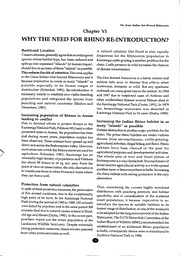
Preview Rhino Bnhs
THE GREAT INDIAN ONE-HORNED RHINOCEROS (RHINOCEROS UNICORNIS)I N INDIA AND NEPAL A Review by Dr Satya Priya Sinha and Bitapi C Sinha t pimHS y toHgh Citation:S inha,S .P. and Sinha,B .C.( 2007). The Great Indian One-Homed Rhinoceros {Rhinoceros unicomis)i n India and Nepal.B ombay Natural History Society, Mumbai. pp.4 6. Photos: S.P. Sinha, Ashish Chandola and Asad R. Rahmani Front cover: Ashish Chandola, Back coiner: Asad R. Rahmani Cover Design and Layout: JPK Menon © Bombay Natural History Society 2007 All rights reserved. No part of this publication may be reproduced, or transmitted in any form or by any means electronic or mechanical, including photocopying, recording or by any information storage and retrieval system' without permission in writing from the Bombay Natural History Society. Enquiries concerning reproduction outside the scope of the above should be sent to the Bombay Natural History Society at the address below. ^ Published by Bombay Natural History Society Hombill House,S haheed Bhagat Singh Road, Mumbai 400 001, Maharashtra,I ndia Tel: (91-22) 22821811 Fax: (91-22) 22837615 Email: [email protected] Website: www.bnhs.org Printed with financial support from CEAT Limited, Mumbai Acknowledgements It would be impossible to thank all those whose suggestions have helped shape this report. We,h owever, wish to mention the names of those who have inspired and guided us in this endeavor. We thank Mr. Ashish Chandola and Ms.S hanthi Chandola for the photographs without which this report would not have seen the light of the day. We owe a particular debt of gratitude to Dr. Usha Hemmadi, who is not in this world anymore but have done the undaunting task of editing this report. Mr.J . C. Daniel & Dr. Rahmani have contributed their thoughts and worked patiently and silently for the report, we appreciate their guidance and suggestions. Our special thanks to them. We are indeed thankful to Mrs. Ruby Madan for opening the doors to such an opportunity which high lights the need for conservation of natural habitat and sustainability of this species. Also we are grateful to Mr.J .P.K. Menon who has designed and formatted the report and the entire Central Marketing Department team of the BNHS to make this report a success. Finally, we are most thankful to the sponsors,C EAT,f or supporting and undertaking this project. Contents Introduction 1 Historical Records on the Great Indian One-Horned Rhinoceros in North India and neighbouring countries 5 Morphological Features of the great Indian One-homed Rhinoceros 10 Indian Rhinoceros in religion, mythology, beliefs and rituals 14 Legal Status 27 Why the Need for Rhino Re-Introduction? 18 Captive Elephant Management for Indian Rhino at Dudwa 27 Need for enlarging the great Indian One-homed rhino habitat, and trans-location of Rhinos in Bhadhital area in Dudhwa National Park 32 The future of the Great Indian One-horned Rhinoceros 36 Bibliography
